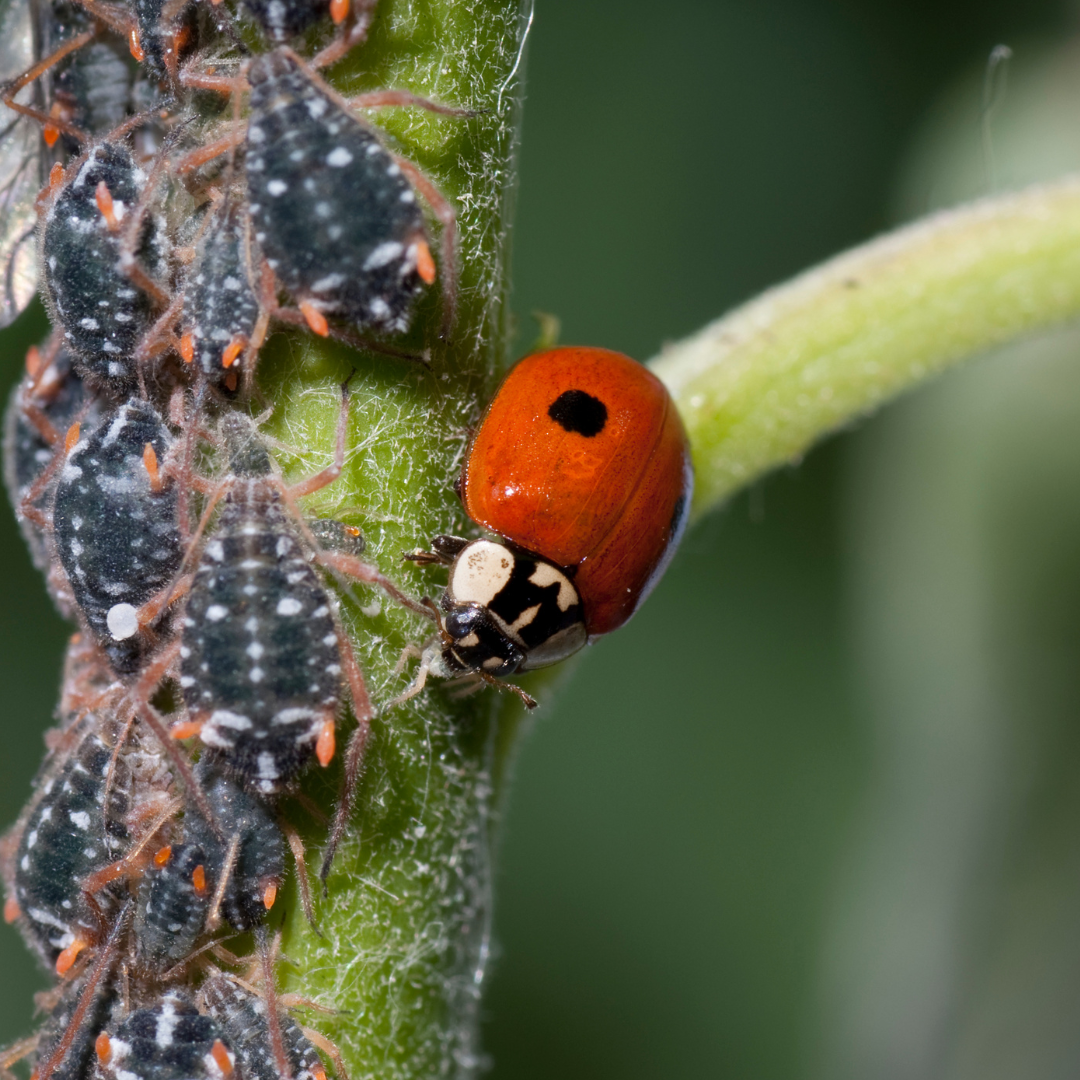Pests and Diseases
Caring for plants is such a wonderful pastime, but one downside is pests and diseases that start to invade your beautiful plants. Pests do not kill your plant immediately but if you do not take action, they can take over and do some damage.
In this list of common pests, you will find they all have the same thing in common. They suck the sap out of leaves. They also can be controlled with the same treatments.
The following are common pests and diseases that can be found in your garden.
Aphids
Aphids are tiny insects ranging in color from black, brown, grey, yellow, orange, and light green. They have pear-shaped bodies and are very fleshy. Young aphids look very similar to adults.
Adult aphids are usually wingless. They move around slowly. If you see winged aphids, it usually means they are older. Aphids are usually found in large groups feeding on plants. If it becomes too crowded, they will move to neighboring plants to feed. They do prefer some plants over others. Petunias and potato vine are some favorites for this insect. You probably have aphids if you find a shiny, sticky coating on your plants. Check the underside of the leaves to spot them.
Neem oil is one product that you can use to treat aphids. If you have a sprayer, you can mix this concentrate with water. Use ready-to-use neem oil if you do not have a sprayer and want to purchase something already mixed.
Insecticidal soaps and horticulture oils are effective against aphids. When sprayed, they must contact the aphids to work. Follow package directions on how to apply.
Spider Mites
Spider mites are not insects. They are spiders. Very, very small. They have eight legs instead of the six legs you find on insects. Because of their small size, they can do much damage before you realize they are there. They pierce a plant and suck out the plant sap in the leaves of plants. They multiply quickly and cause leaves to become dull-looking, and yellow, and eventually fall off the plant.
The first sign is that your plant does not look happy. Sort of dull looking. Leaves may be curled or have a stippled effect. Fine webbing may be present under the leaves or where the leaves attach to the stem. To locate spider mites, take a white sheet of paper and place it under the leaves. Tap the leaves to see if these spiders fall onto the paper. These are probably spider mites if you see tiny little brown spots moving around.
The life cycle of a spider mite is very short (2-3 weeks), so you must be diligent when treating an infested plant. Repeat the treatments to keep ahead of the changing life cycles.
Neem oil, insecticidal soaps, and horticulture oils are effective against spider mites. Miticide is also an effective chemical to use. When sprayed, they must contact the mites to work. Follow package directions on how to apply.
Whitefly
The whitefly is a soft-bodied insect with wings, but not considered a fly. They are small insects, triangular in shape, and live in clusters on the underside of leaves. They feed during the day. If you are moving a plant and find many white insects flying around when you disturb the plant, these are probably whitefly. Whiteflies like warmer temperatures and are usually not around when it is colder.
Whiteflies can be found in a wide variety of plants. Tomatoes, eggplant, peppers, okra, sweet potatoes, and common houseplants.
Whiteflies use their mouth to pierce a plant and suck up the juices in the plant leaf. Like aphids, they leave a sticky, shiny substance behind called honeydew. This honeydew, if left, can cause a fungal disease such as sooty mold to form. Honeydew is a sign that the whitefly has been present for some time.
Whiteflies feed on new growth. They live on the underside of plant leaves, especially around the veins. Where you find whitefly, you also may find eggs on the underside of the leaves. They are small pale yellow spots stuck to the leaf. They turn brown just before they are about to hatch. The larvae immediately start feeding on the plant when they hatch, even though they do not move.
Plants become weak when whitefly are in large numbers. Leaves will wilt, growth may be stunted, turn yellow and eventually fall off.
Neem oil, insecticidal soaps, and horticulture oils are effective against whitefly. When sprayed, they must contact the whitefly to work. Follow package directions on how to apply. Whitefly can be a difficult insect to control as one adult female can lay up to 400 eggs
If you want a home remedy, a homemade mixture of good quality dish soap and water (ratio of 40:1) - 40 parts water, 1 part dish soap is an effective spray against most garden pests. Spray late in the day. The spray must come in contact with the insect. Leave the spray on the plant for 15 minutes, then rinse the plant off, so you do not close the plant's pores.
Mealy Bug
Mealybugs are plant-sucking pests and can be a problem in a greenhouse, in gardens, and on indoor plants. They hide, so they are hard to find.
Mealybugs are present when it is warm. They are soft-bodied, have no wings, and look like white cottony masses on plants' leaves, stems, and fruit. They are a type of scale. With their mouth, they suck up sap out of the plant's tissue. When there are many meal bugs present, they can cause damage, such as leaf yellowing and curling. The plant will become weak and eventually die. The feeling will leave a stick substance behind, leading to sooty mold.
Once mealybugs find a place to feed, they do not move much. They are small, but their white powdery appearance makes them easy to spot.
An adult female will deposit 300-600 eggs on the underside of leaves. The female will die shortly after laying the eggs. The eggs hatch within 1-3 weeks.
The mealybug is an easy insect to spot due to its appearance. If can be found on a plant's stems, leaves, and fruit. It is difficult to find all of them because they hide in the soil and parts of the plant that you must peel back to spot them. Neem oil, insecticidal soaps, and horticulture oils are effective against mealybug. When sprayed, they must contact the insect to work. Follow package directions on how to apply. Rubbing alcohol is a good control for mealybug, and if used carefully, does not harm the plant.
Scale
Scale is a common problem with many houseplants. They suck the sap out from the leaves of plants, taking essential nutrients the plants need to survive.
Scale like warm climates. It is a small oval and flat bug with a protective tan to brown shell. Scale can be found on the undersides of leaves and around the leaf joints. Mealybug is a type of scale with a soft body. The armored scale has a hard body and is harder to control.
Plants damaged by scale look withered and sick. Leaves turn yellow and may drop from the plant. Scale can leave a honeydew sap behind after feeding that is shiny and sticky. This substance can form a sooty mold on the leaves.
Neem oil, insecticidal soaps, and horticulture oils are effective against scale. When sprayed, they must contact the insect to work. Follow package directions on how to apply. Rubbing alcohol is a good control for scale, and if used carefully, does not harm the plant.
If you want a home remedy, a homemade mixture of good quality dish soap and water (ratio of 40:1) - 40 parts water, 1 part dish soap is an effective spray against most garden pests. Spray late in the day. The spray must come in contact with the insect. Leave the spray on the plant for 15 minutes, then rinse the plant off, so you do not close the plant's pores.
Botrytis
Botrytis is also known as grey mold. It is a fungus.
Botrytis starts as a white growth on a plant but soon turns grey. The dusty spores are easily spread by air movement or water. It is common in ornamental shrubs, trees, garden vegetables, and perennials. It is most common after the spring rains and usually begins on dead or dying flowers and spreads with humid weather.
To locate botrytis, look for signs of mold that is grey or grey mushy spots appearing on produce, flowers, stems, and leaves. The plant will become shriveled with black fungus beneath the rotted area.
To treat botrytis, cleaning the affected area is first needed. Pick up and destroy infected leaves, fruit, flowers, and stems. Heavily infected areas should be pruned off with clean pruners. To rid your debris, it should be buried at least 12" down in the soil. If you can burn the debris, that would also be effective. Check your local regulations for burning.
An effective control for botrytis is trying to keep plants dry. Do not water the plant leaves, and keep good air movement around the plant. Neem oil also works on botrytis.
Powdery Mildew
Powdery mildew is a white fungus on the leaves of your plant. It looks like someone took flour and sprinkled it over your plant.
Powdery mildew affects a wide variety of plants. It mostly affects ninebark, squash, pumpkins, cucumbers, melons, tomatoes, eggplant, roses, beans, and peas.
When this fungus takes over your plant, it slows down the growth, and if the infection is serious, it will reduce yields and can eventually cause the death of your plant.
Powdery mildew has spores that drift into your garden with the wind. If you have had problems, the soil may have dormant spores. Powdery mildew thrives in warm conditions but favors high humidity. If it is a humid summer, you will find powdery mildew in many more plants.
To locate powdery mildew, it looks like your plant was dusted with flour. It starts as a circular powdery white spot, It covers the upper part of the leaf but will eventually cover everything. Young foliage is damaged first.
Powdery mildew is hard to control when conditions are favorable to it. Shady areas are more susceptible to it as well.
To prevent it, treat plants with a fungicide such as neem oil to treat powdery mildew. This can be sulfur, lime-sulfur, neem oil, and potassium bicarbonate. These are the most effective when you see the first signs of the fungus.
Mix one teaspoon of baking soda in 1 quart of water to make a homemade solution. Spray plants thoroughly. The spray must contact the fungal spores to be effective.
To learn more about pest control, check this Pest Control Library










